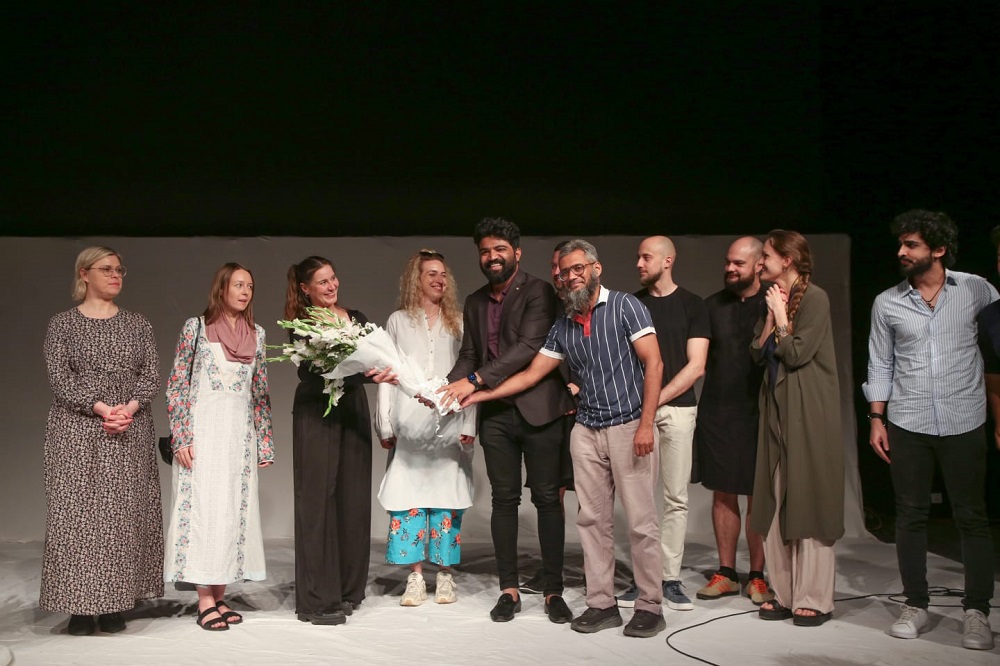Written by: Hurmat Majid
Posted on: March 17, 2023 |  | 中文
| 中文
The emotional turmoil unfolds on stage as Greta performs
In this world where mothers are either goddesses or monsters from hell, not having any picture of a mother at all is hard to imagine. How does one put it together? Is it needed at all? How does one live without a portrait of their mother?
What is the first memory of your mother? It is a question often asked to make conversation and often answered quite mechanically by people. But what if you have no memory, and you can’t remember?
These are the themes being explored by Greta Grinevičiūtė’s Dance for Washing Machine and A Mother, presented by the theatre group MMLAB based in Vilnius, Lithuania. The performance took place at Arts Council, Karachi. The play has been produced by Rusnė Kregždaitė and written by both Sigita Ivaškaitė and Kristina Steiblytė, and the music composed by Agnė Matulevičiūtė.
The play is the second of the triptych that the Lithuanian artist started working on in 2018, when she came out with Dance For a Vacuum Cleaner and a Father. The final part of the series, Dance for a Thing and a Child was also adapted by Sohail Malik and presented by Pakistani performers as Aik Raqs Kisi Shay Aur Bachhay Kay Naam, in a performance preceding Greta’s act. Both plays, even though different from what a Karachi crowd is used to, were well received.
One of the first things one notices about the play is the prologue, where Greta is seen spray painting an image on the walls on stage, mesmerized she goes about her work while the audience settles down and tries to understand her actions, before getting fully engrossed in the performance. Another wave of confusion occurs when the performer receives a video call on stage, and Greta changes her different costumes on stage while performing. Then the real action in the single-person story begins.
The conceptual dance performance takes audiences through an array of emotions. From confusion to understanding, to empathy. One can feel the energy in the theatre shift as the mood of the audience undergoes a change with the performance.
The play introduces another unconventional practice with the use of a multimedia screen to project the performer’s actions via a live feed on stage. The screen was also used to project subtitles, but its greater purpose was to show a close-up of the performer’s expressions so the audience can see her raw emotions.
“Because we will never get to talk again, but maybe we can still dance together. Surely, we will dance together” Greta’s last words resonated on stage, followed by a moment of silence before the audience broke into roaring applause.

Director ACP Daniyal Umer and Theatre Director Zeeshan Haider welcome the team of 'A Dance for a Washing Machine and a Mother'
In the Urdu adaptation of A Dance for A Thing and A Child, which was presented through the collaboration of the Arts Council of Pakistan Karachi and Karachi Drama Circle, we see themes of societal pressure and responsibility being discussed, the context being the couple’s need to excessively defend their choice of having or not having children. The theme was portrayed through a few short segments including a lighthearted take on childrearing, a live song and dance about letting children dream freely, a monologue and a free-form dance performance.
The play opened with a dialogue over the insensitivity and intrusion that a couple, especially a wife or mother, have to endure in our society. Difficult themes like post-partum depression and parental guilt were explained to the audience in a palatable manner. This performance was also well received, considering that these issues are generally considered taboo in our society.
Discussing her idea, Greta said her three plays all question the preconceived notions of a picture-perfect family, especially regarding child-rearing and childbirth.
H.E Mr Ričardas Degutis, the Ambassador of Lithuania to Pakistan, who was present at the performance said: “The people of Pakistan have now experienced our theatre, where we first make you sad, then crack a few jokes and then make you feel pain again. I used to joke that Lithuanian basketballers are everywhere in the world, now we can go tell the world that our theatre artists are also everywhere, especially in Pakistan.”
Overall, the plays were a good introduction to conceptual theatre for Pakistani audiences, and now Pakistani theatre maestros can explore a genre of the art form that previously they were not familiar with.
You may also like: